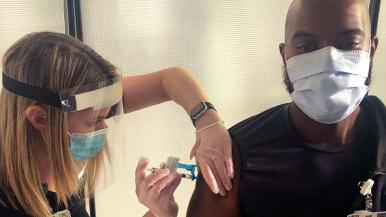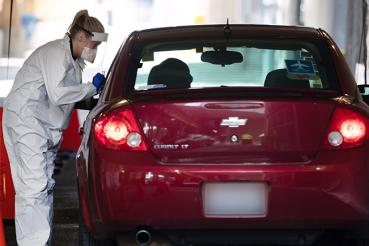The race to deliver the COVID-19 vaccine has dominated the news of 2021. While appointment availability was originally limited to certain groups, now everyone age 12 and older can get one. To date, only about 48% of the U.S. population has been fully vaccinated, and experts say that to reach herd immunity, we need that number to be closer to 70% to 80%.
The COVID-19 vaccines have gone through rigorous testing for safety and effectiveness, and they have been found to be both safe and effective at preventing COVID-19. However, some people remain hesitant about receiving the COVID-19 vaccine.
We talked to Carl Lambert, MD, a family medicine physician, about how he addresses vaccine hesitancy with his patients and how he encourages them to get vaccinated.
Fostering trust
Lambert spends a lot of his time counseling patients and building relationships with them, “which ultimately helps you to foster trust,” he says.
Because COVID-19 is a new virus, the guidelines and information about it have continued to change and evolve. However, the constantly shifting information has led to a good amount of public distrust and confusion. Additionally, patients have been unable to see their doctors as frequently, which means they may not have had a chance to discuss their concerns about COVID-19 and the vaccines with the providers they trust and know best.
There is also a lot of distrust of the medical community among people of color. The historical mistreatment of members of the Black and Latinx communities by the medical community has played a role in shaping these communities’ overall fears, concerns and hesitancy about the vaccine.
“You need to really think from the patient’s perspective,” Lambert says. “Figure out, why is there hesitancy? And from there you can work to address those causes, whether they are fear, distrust or something else.”
Vaccine safety and the Johnson & Johnson pause
The recent pause of the Johnson & Johnson vaccine, one of three available, also caused concern. From Lambert’s perspective, the best way to address this is through statistics: the risk of a blood clot from the Johnson & Johnson vaccine is close to seven in a million for women under age 50 (and even lower for women over age 50), but the risk of a blood clot from COVID-19 is far higher.
“I think the Johnson & Johnson vaccine pause was thoughtful,” Lambert says. “But there was so much sensationalism and speculation behind it, that I think it added to the distrust. If you pause for too long, you can lose credibility, which leads to more people not getting vaccinated, and [that] exacerbates the problem.”
To combat hesitancy, Lambert suggests having a direct, educational dialogue with patients. “It’s really about thoughtful conversations,” Lambert says. “For me as a doctor, the science behind vaccines and why they work is very familiar to me and trusted, but for patients, it can be a completely new thing.”
He offers these helpful tips for presenting information to patients:
- Break down complex information into everyday terms.
- Discuss the benefits and potential risks of vaccines as well as the differences between the available COVID-19 vaccines.
- Educate patients while emphasizing how COVID-19 can affect their daily lives and why the vaccine is good for them and their loved ones.
Finally, Lambert recommends highlighting how the vaccine is good for the larger community. We all have to do our part to end the pandemic, he says, and combating vaccine hesitancy is one of the best ways to do that. It’s also important to welcome questions, Lambert says. “There are no silly questions, and no finger-pointing or shaming. You need to speak at the patient’s level to help address their concerns.”
The approval of the Pfizer vaccine for kids 12 to 15 has also sparked more questions from many. Learn more about the COVID-19 vaccines and kids here.
Improving access will decrease hesitancy
Making the COVID-19 vaccine accessible for everyone also plays a key part in reducing hesitancy, says Lambert.
“Improper access can exacerbate any existing vaccine hesitancy. Addressing systemic barriers and ensuring proper access is the only way we’re going to get more people vaccinated,” he says.
The fact that Black and brown communities have been disproportionately affected by COVID-19 is a product of poor access to health care, too.
According to Lambert, primary care is a key aspect of increasing health care access in general. “Having a patient-centered medical home is crucial to increasing access for many patients,” he says. “Ensuring primary care for everyone can also help decrease the likelihood that certain populations will have risk factors that put them at higher risk for severe COVID-19.”
With the COVID-19 vaccines specifically, it’s important to get rid of as many obstacles as possible to make sure patients can access it. “A multifaceted approach that relies on reducing barriers and engaging community partners is what’s needed to increase vaccine numbers,” Lambert says.
The role of vaccine ambassadors
Vaccine ambassadors are a powerful tool in the effort to increase vaccination numbers. Community partners like pastors can help health professionals identify any blind spots in vaccine rollout plans, according to Lambert. They can also show humility, grace and concern when talking to community members about the COVID-19 vaccines.
“I am an African American physician — but I’m still a physician. People may see me as part of the machine and may not trust me, which is why ambassadors like pastors and other trusted community advocates and stakeholders can be extremely helpful in certain communities,” Lambert says.
Vaccine ambassadors should be people who live in the community and who have a proven track record of engaging with its members. These people can convince or encourage community members to get the vaccine.
Lambert has experienced the power of vaccine ambassadors firsthand. “My father-in-law is a pastor, and I came and talked to our congregation about the COVID-19 vaccine, but it was a whole other thing to see the community’s reactions when my father-in-law talked to them after I did. I saw people’s faces show relief, comfort and less hesitancy overall.”
Vaccine incentives
Vaccine incentives have recently surfaced in the news in many states hoping to increase vaccination rates. In New York, individuals who get their vaccine can choose an incentive like free tickets to sports games and city sights, as well as a sweepstakes competition.
United Airlines recently launched its “Your Shot to Fly” sweepstakes. The Chicago-based airline plans to give away 30 pairs of round-trip tickets in June to those who can prove they have been recently vaccinated, and it also will select five winners to receive free travel for a year for themselves and a companion.
In Illinois, Cook County Health has offered free Six Flags amusement park tickets to those who get vaccinated.
Lambert thinks these kinds of incentives can be a helpful tool, depending on what is being offered.
“It could be seen as a little disingenuous to some — like, ‘Why are you offering this now, if you could have done it at the beginning?’” he says. It remains to be seen if providing such incentives will be effective in boosting vaccination rates.
Free food or a small giveaway may be fine as incentives, Lambert says, but if someone is offering to pay your medical bills, that could potentially be seen as suspicious by some.
Combating ‘gut feelings’
At the beginning of the COVID-19 vaccine rollout, hesitancy was largely seen as an educational issue. However, as the rollout continued, it’s been noted that some people simply have a “gut reaction” to not getting the COVID-19 vaccine.
Lambert encourages his patients who say they have a “gut feeling” to identify the reason. “I ask them, ‘What do you mean by your gut?’ Underneath, there might be fear, anger or a bigger ‘why,’ and that’s what I want to get to. Once I identify that, I can tailor my conversation to address their underlying reason.”
Lambert also says he keeps communication open with his patients. He reiterates the following points in his conversations to let patients know he is a resource for them:
- Even if you’re not open to receiving the vaccine right now, I’m always going to ask you and give you the option in future encounters, because situations and answers may change.
- If you change your mind, that’s OK.
- If you have questions, bring them to me.
“Structuring my conversations in this way opens the door to a more candid and honest conversation, and I think that’s really what’s going to help encourage people to get vaccinated,” Lambert says. “Honesty, humility and genuine care and communication.”




